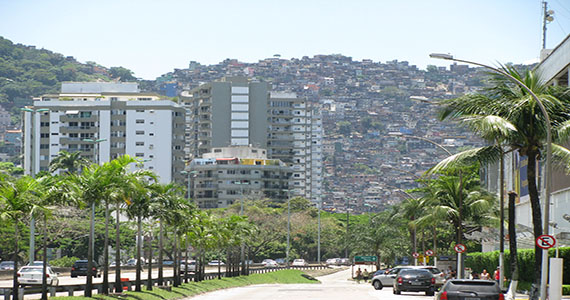
Raoni/Flick.com via Creative Commons
By: Waleska Teixeira Caiaffa, MD, MPH, PhD; Amélia Augusta de Lima Friche, MPH, PhD; Rebecca Barbosa de Decco Marinho, MPH; Amanda Cristina de Souza Andrade, MPH, PhD; Lidia Maria de Oliveira Morais, MHS; and Maria Angélica Salles Dias, MD, MPH
*All authors are affiliated with the SALURBAL Team of the Observatory for Urban Health-Belo Horizonte at the Federal University of Minas Gerais in Brazil.
Urban violence and its pervasiveness are not unique to Brazil. Cities home to just 11% of the world’s population account for 46% of all homicides in the world. All of them are located in the Americas and Africa. Worldwide, there are more than 1.3 million deaths annually as a result of all forms of violence, corresponding to 2.5% of global mortality. The Brazilian Atlas of Violence (2018), World Health Organization (WHO), and United Nations (UN) indicators that have consistently shown that homicides tend to be spatially concentrated in Latin American within Latin American countries. Brazil, regrettably, has always ranked among the most violent nations globally.
Violence has roots in historical and social phenomena in Brazil and has been on the rise since the 1960s. Trends in violence can only be partially attributed to Brazil’s democratic transition away from an authoritarian regime. The role of urbanization and its related challenges should be taken into account, including their role in amplifying unresolved social problems, resulting in inequitable access to economic and social rights across large segments of the population, markedly in urban areas. From the 1980s, violence spread to endemic proportions in cities, being one of the most sensitive issues among Brazil’s struggles with urbanization. At that time, violence rates grew approximately 29%, with violent death becoming the second most prevalent cause of death. In the 1990’s homicides ranked first among external causes of death, increasing another 27.5% through the beginning of 2000. With some periods of slowed growth and fluctuations, homicides rates again began to increase in 2006 reaching 62,517 annually in 2016, equivalent to a rate of 30.3 deaths for every 100 thousand inhabitants (30 times the rates observed in European Countries).
SNAPSHOT OF VIOLENCE IN BRAZIL
WHO IS AFFECTED?
Youth: Men (homicides mainly on streets) and Women (femicides mainly in the home)
People of Color: In the non-black population, the homicide rate has declined by 6.8% in the last ten years. In the black population, it has increased by 23.1%. 71.5% of the people who are murdered each year in Brazil are people of color.
WHERE IS THE VIOLENCE?
Huge heterogeneity across regions of the country, states, cities, and neighborhood linked to social, political, and economic determinants.
WHAT TO DO?
Understand and invest in an institutional architecture that empowers the Brazilian state and guarantees the tools of governance so that it can effectively implement public and social policies.
Multiple and complex determinants of violence can be aggravated by urban settings and compound in grave health inequities and the deprivation of equal opportunities for all. A closer look at the burden of violence reveals striking differences linked to gender, age, place of residence and socioeconomic status. These disparities arise against the backdrop of high income inequality, industrialization, and macroeconomic policies through which the preponderance of capital over people relegated disadvantaged groups to the peripheries of cities. This physical and social isolation promotes invisibility, exclusion, and political disenfranchisement that the drug trade and other non-state actors have often exploited.
Such cycles of violence have implications for health, demographic dynamics and the process of economic and social development. One illustrative fact that characterizes the proportion of the problem is the staggering rate of homicides as a cause of mortality among the male youth (15-29 years), which in 2016 in Brazil corresponded to 50.3% of all deaths in this demographic. If we consider only the youngest of this group (15-19 years), this indicator reaches the incredible mark of 56.5%. Lost youth is a major problem on the road to social development in the country.
Although violent death is perhaps the most visible and alarming indicator official statistics, it represents only the top of the problem, evidenced the WHO’s injury pyramid. Beyond mortality, cases of violence result in hospitalization, emergency department visits, and injuries broadly speaking (both those for which care is sought and those unreported). Thus, we still work with a high degree of underreporting, especially in the case of intra-familiar violence that does not result in death. Figure 2 draws on our local example of Belo Horizonte, breaking down the distribution of the burden of adolescent injuries due to violence, per 100,000.
FIGURE 1: The Injury pyramid of adolescents in Belo Horizonte, Brazil

This situation is neither a problem exclusive to Belo Horizonte nor to Brazilian cities. What we see today, especially in the cities of South and Central America, is the glaringly failure to meet the basic human right to exist free from violence. In this blog, we highlight the importance of understanding the profile touching the causes and urban policies that may at first glance seem unrelated to health, yet are likely to have an important impact on the health and wellness of residents.
It is time for a proactive causal architecture approach to violence, one of the main goals of the SALURBAL Project.
--
This post was written by Waleska Teixeira Caiaffa, MD, PhD, MPH and Amélia Augusta de Lima Friche, PhD, MPH, along with the OSUBH team, as a contribution to Cities, Sectors, and Health, run by SALURBAL. To contact the blog or learn more about the SALURBAL project email salurbal@drexel.edu.